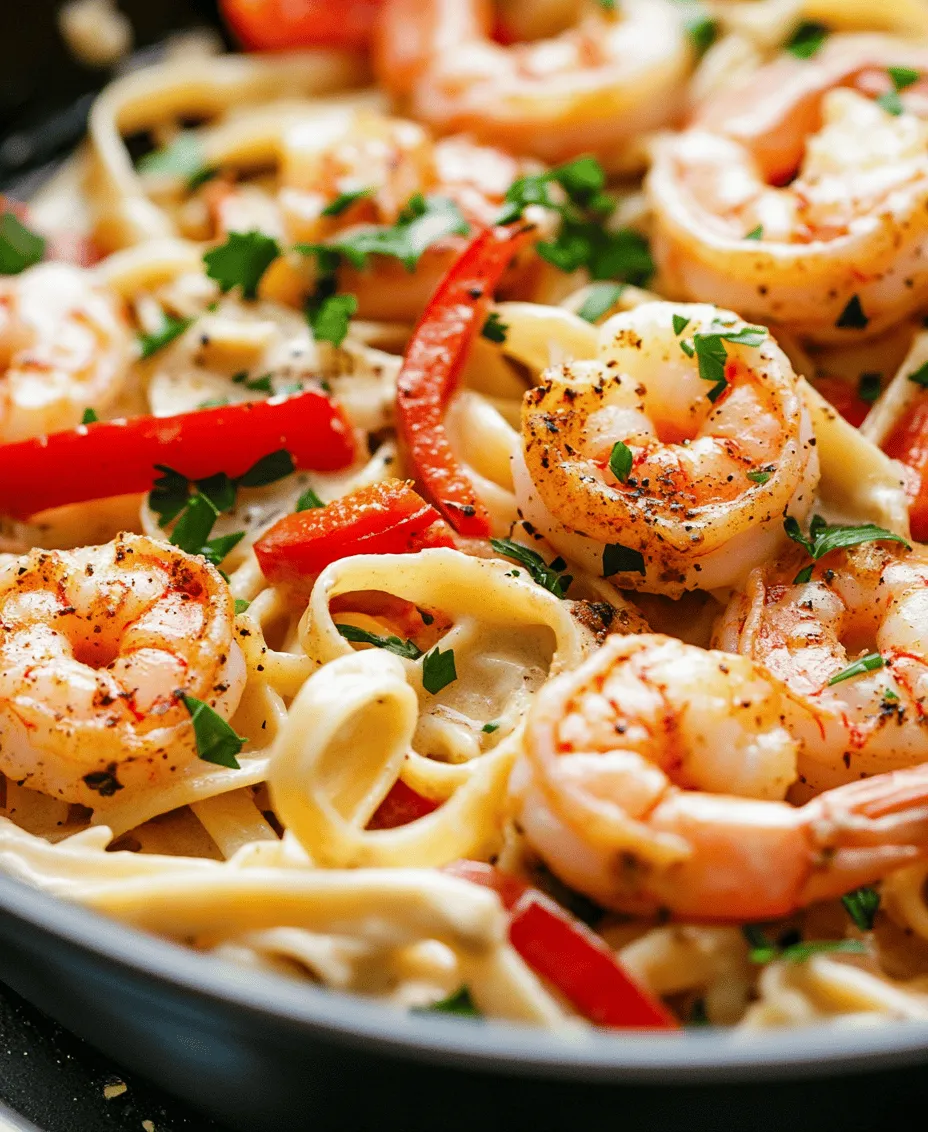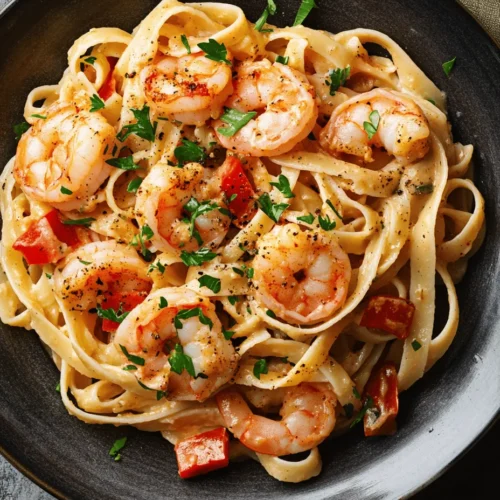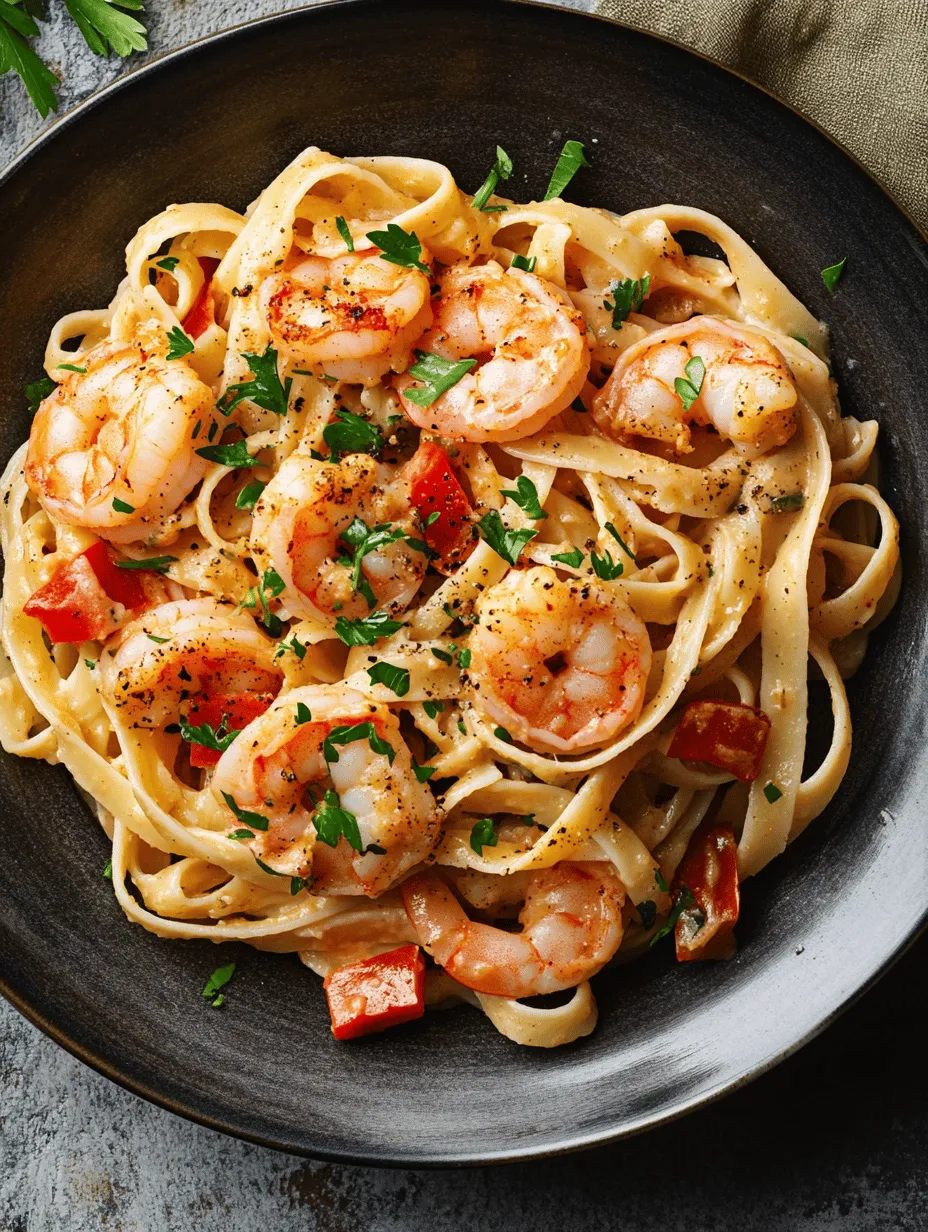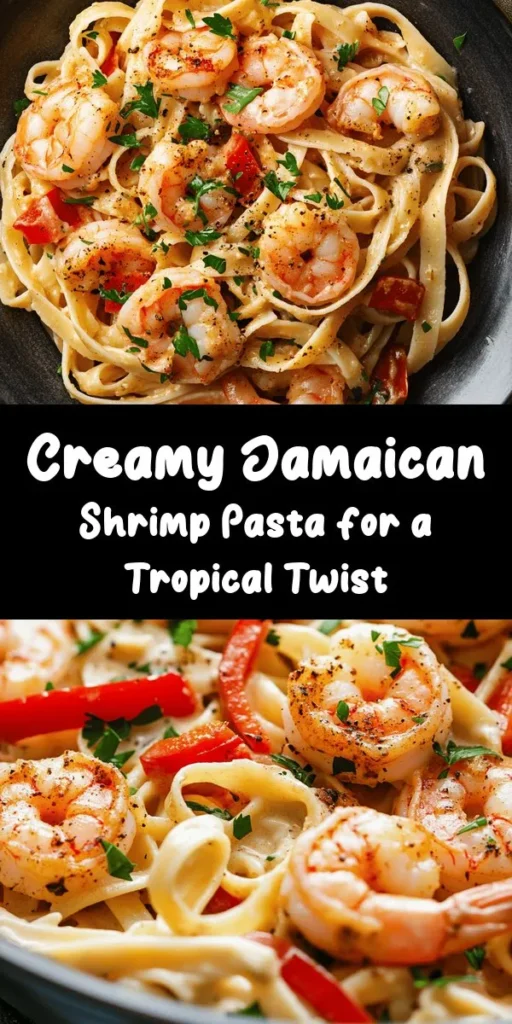Introduction
Jamaican cuisine is a vibrant tapestry woven from the rich cultural influences of Africa, Spain, the indigenous Taino people, and beyond. Known for its bold flavors and aromatic spices, Jamaican food offers a culinary adventure that captivates the senses. Among the myriad of dishes that showcase these unique flavors, Jamaican Shrimp Pasta stands out as a delightful fusion that brings together the creamy indulgence of pasta with the zest and warmth of traditional Jamaican spices. This recipe is not just a meal; it’s an invitation to embark on a culinary journey to the Caribbean, right from your kitchen.
Imagine a plate of perfectly cooked fettuccine coated in a luscious, creamy sauce, enhanced by the fresh, succulent shrimp, and invigorated with the punch of jerk seasoning. The harmony of these ingredients creates a dish that is both comforting and exotic, making it a perfect choice for a family dinner, a romantic date night, or a festive gathering with friends. As we delve into the details of this tropical-inspired pasta dish, you’ll discover how to create your own version of Jamaican Shrimp Pasta, ensuring that each bite transports you to sun-soaked beaches and swaying palm trees.
Understanding the Key Ingredients
To master the art of Jamaican Shrimp Pasta, it’s essential to understand the key ingredients that contribute to its distinctive flavor profile. Each component plays a vital role in creating a dish that is not only delicious but also embodies the spirit of Jamaican cooking.
Fettuccine Pasta
Fettuccine is a flat, thick pasta that is perfect for creamy sauces. Its wide surface area allows it to hold onto the sauce beautifully, ensuring that each bite is packed with flavor. When cooked properly, fettuccine has a tender yet slightly chewy texture that complements the dish’s richness. For this recipe, cooking the fettuccine to al dente is crucial; it should be firm to the bite without being overly soft. This not only enhances the overall texture of the dish but also ensures that the pasta stands up well to the creamy sauce and shrimp.
Shrimp
Fresh shrimp is the star of this dish, bringing a sweet, briny flavor that pairs wonderfully with the creamy sauce. When selecting shrimp, look for those that are firm and translucent, with a mild ocean scent. Avoid shrimp that has a strong fishy odor, as this can indicate poor quality. For this recipe, medium to large shrimp works best, as they provide a satisfying bite and hold their shape during cooking. Before cooking, be sure to clean the shrimp by peeling and deveining them—this step is essential for both presentation and taste.
Coconut Milk
A hallmark of Caribbean cuisine, coconut milk adds richness and creaminess to Jamaican Shrimp Pasta. Made from the flesh of mature coconuts, coconut milk has a distinct flavor that complements the spices in the dish while creating a smooth and velvety texture. Its sweetness balances the heat of the jerk seasoning, making it a perfect companion for the shrimp and fettuccine. Additionally, coconut milk is a staple in many Jamaican dishes, making it an essential ingredient that honors the culinary traditions of the island.
Jamaican Jerk Seasoning
No Jamaican dish would be complete without the iconic jerk seasoning. This blend of spices typically includes allspice, thyme, scallions, garlic, and Scotch bonnet peppers, creating a flavor profile that is both aromatic and spicy. The heat from the Scotch bonnet peppers is balanced by the earthy notes of allspice, resulting in a complex seasoning that elevates the dish to new heights. For this recipe, you can either use a store-bought jerk seasoning or create your own blend at home. The key is to incorporate enough seasoning to impart that unmistakable jerk flavor without overpowering the other ingredients.
Lime Zest and Juice
Lime is a quintessential ingredient in Jamaican cooking, known for its ability to brighten flavors and add a refreshing zing. In this pasta dish, lime zest and juice play a crucial role in balancing the richness of the coconut milk and shrimp. The acidity of the lime cuts through the creaminess, enhancing the overall flavor and providing a burst of freshness. When preparing your dish, be sure to use fresh limes for the best taste; the zest adds an aromatic quality, while the juice provides the necessary acidity.
Creating the Perfect Jamaican Shrimp Pasta
Now that we’ve explored the essential ingredients, it’s time to dive into the step-by-step process of creating this delicious dish. Follow these instructions closely to ensure that your Jamaican Shrimp Pasta turns out perfectly every time.
Cooking the Fettuccine
1. Boil Water: Start by filling a large pot with water and bring it to a rolling boil. For every pound of pasta, you’ll want to use about 4 to 6 quarts of water. Adding a generous amount of salt to the water is crucial, as it enhances the pasta’s flavor.
2. Add the Pasta: Once the water is boiling, add the fettuccine. Gently stir to prevent the pasta from sticking together.
3. Cook to Al Dente: Follow the package instructions for cooking time, usually around 8-10 minutes. To achieve the perfect al dente texture, taste the pasta a minute or two before the timer goes off. It should be firm but not crunchy.
4. Reserve Pasta Water: Before draining the pasta, reserve about a cup of the starchy pasta water. This water can be added to the sauce later to achieve the desired consistency.
5. Drain and Rinse: Once the pasta is cooked to perfection, drain it in a colander. Avoid rinsing the pasta, as this will wash away the starch that helps the sauce cling to it.
Sautéing the Shrimp
1. Prepare the Pan: In a large skillet, heat a tablespoon of olive oil over medium heat. The oil will help prevent the shrimp from sticking and provide a nice flavor.
2. Add the Shrimp: Once the oil is hot, add the cleaned shrimp to the skillet in a single layer. Avoid overcrowding the pan, as this can cause the shrimp to steam rather than sauté.
3. Season the Shrimp: Sprinkle your desired amount of jerk seasoning over the shrimp. The shrimp will cook quickly, so be ready to turn them after about 2 minutes. Use a spatula to flip them over when they turn pink and opaque.
4. Cook Until Done: Sauté the shrimp for an additional 1-2 minutes on the other side until they are fully cooked and have a nice golden color. Remove the shrimp from the skillet and set them aside on a plate, allowing them to rest while you prepare the sauce.
5. Building the Sauce: In the same skillet, lower the heat and add coconut milk, lime juice, and any remaining jerk seasoning. Stir to combine and let it simmer for a few minutes to meld the flavors.
With the fettuccine cooked and the shrimp sautéed to perfection, you are well on your way to creating a mouthwatering Jamaican Shrimp Pasta. The next steps will involve combining these elements into a harmonious dish that showcases the vibrant flavors of the Caribbean. Stay tuned as we explore how to complete this delightful recipe and serve it to your eager guests!

Techniques for Sautéing Shrimp
To achieve perfectly sautéed shrimp that are tender and bursting with flavor, it’s essential to follow a few key techniques. Begin by ensuring that your shrimp are properly thawed if you’re using frozen ones; this can be done by placing them in cold water for about 15-20 minutes. Pat them dry with paper towels to remove excess moisture, which helps achieve a nice sear.
Heat a large skillet over medium-high heat and add a tablespoon of oil—olive oil or coconut oil works beautifully. Once the oil is shimmering, add the shrimp in a single layer. Avoid overcrowding the pan, as this can lead to steaming instead of sautéing. Cook the shrimp for about 2-3 minutes on one side until they turn pink and opaque, then flip them over and cook for another 1-2 minutes. The shrimp are done when they curl into a C shape and are no longer translucent. Season lightly with salt and pepper during cooking to enhance their natural flavor. Once cooked, remove the shrimp from the skillet and set them aside, covering them to keep warm.
Preparing the Flavorful Sauce
Creating a rich and flavorful sauce is the heart of this Jamaican Shrimp Pasta. Start by using the same skillet where the shrimp were cooked; this not only minimizes cleanup but also allows you to capture the fond (the caramelized bits left in the pan) which adds depth to your sauce.
Begin by adding a splash more oil if necessary, followed by finely chopped onions and bell peppers. Sauté these vegetables over medium heat for about 5-7 minutes until they become soft and aromatic. The key here is to take your time; allowing the vegetables to brown slightly will develop a deeper flavor base. If you like a little heat, you can also add minced garlic and ginger at this stage, cooking just until fragrant, about 30 seconds.
Next, incorporate diced tomatoes (fresh or canned) to add acidity and sweetness to the sauce. Stir everything together, allowing the mixture to simmer for a few minutes, letting the flavors meld. This step is crucial as it sets the stage for the creamy elements to come.
Incorporating Coconut Milk and Seasoning
Now, it’s time to transform your vegetable medley into a luscious sauce by adding coconut milk. Pour in a can (about 400 ml) of full-fat coconut milk, stirring well to combine with the sautéed vegetables. The coconut milk will provide a creamy texture that complements the shrimp beautifully.
To enhance the flavor profile, introduce jerk seasoning. This spice blend, which typically includes allspice, thyme, ginger, and Scotch bonnet pepper, brings a signature kick to the dish. Start with one to two tablespoons, adjusting according to your taste preference. As the sauce simmers for an additional 5-10 minutes, the flavors will deepen and meld, creating a rich and aromatic base.
Combining Ingredients for a Harmonious Dish
With your sauce ready, it’s time to bring everything together. First, cook your pasta according to package instructions; fettuccine or linguine is a great choice for this dish. Reserve a cup of pasta water before draining, as this starchy liquid can help adjust the consistency of your sauce if needed.
Once your pasta is cooked, add it directly to the skillet with the sauce, tossing gently to coat the noodles evenly. Then, reintroduce the sautéed shrimp to the skillet, mixing everything together. If the sauce seems too thick, gradually add reserved pasta water until you reach your desired consistency. The goal is to have a creamy sauce that clings to the pasta and shrimp beautifully without being overly watery.
Garnishing and Presenting the Dish
A visually appealing presentation can elevate any dish, and Jamaican Shrimp Pasta is no different. To garnish, finely chop fresh parsley or scallions and sprinkle them generously over the top just before serving. This adds a pop of color and freshness that contrasts nicely with the creamy sauce.
For serving, consider using a large, shallow bowl. Twirl the pasta into nests for an elegant look, topping each nest with shrimp. Drizzle any remaining sauce over the top and serve with lime wedges on the side for an extra zesty kick. Not only does this enhance the flavor, but it also adds a vibrant touch to the dish.
Exploring Variations and Customizations
One of the joys of cooking is the ability to adapt recipes to fit personal preferences or dietary needs. Below are some suggestions for variations and customizations to enhance your Jamaican Shrimp Pasta experience.
Adding Extra Vegetables
Incorporating additional vegetables not only boosts the nutrition of your dish but also adds texture and flavor. Consider adding sautéed zucchini, spinach, or snap peas. You can add these vegetables at the same time you incorporate the tomatoes, allowing them to cook down and blend with the sauce.
Adjusting the Heat Level
If you enjoy a bit more heat, consider using a Scotch bonnet pepper, finely chopped, when you sauté the vegetables. Alternatively, if you prefer a milder dish, you can substitute with a milder pepper, such as a jalapeño, or simply reduce the amount of jerk seasoning used. Flavor can still be achieved with fresh herbs and spices without overwhelming the palate.
Substituting Ingredients
For those with dietary restrictions or preferences, there are several substitutes that can be made. Use gluten-free pasta for a gluten-free option, or opt for whole wheat pasta for added fiber. Additionally, if you’re looking for a plant-based alternative, consider using plant-based shrimp or tofu to keep the creamy sauce while making the dish suitable for vegans.
The Cultural Significance of Jamaican Cuisine
Jamaican cuisine is a vibrant tapestry woven from the island’s rich history, cultural influences, and abundant natural resources. Seafood, such as shrimp, plays a significant role in traditional Jamaican dishes, reflecting the island’s coastal geography and love for fresh ingredients. The use of jerk seasoning in this pasta dish highlights Jamaica’s culinary creativity, where bold flavors come together in unexpected ways.
Pasta, although not native to Jamaica, has been embraced and adapted by local chefs, showcasing the fusion of cultures and tastes. This dish not only serves as a delicious meal but also represents the harmonious blend of Caribbean and international flavors—an embodiment of Jamaica’s dynamic food culture.
Conclusion
Jamaican Shrimp Pasta is more than just a meal; it’s an experience filled with the vibrant flavors of the Caribbean. This creamy delight combines tender shrimp, perfectly sautéed vegetables, and a rich coconut milk sauce that encapsulates the essence of Jamaican cuisine. Embrace the joy of cooking and sharing this dish with friends and family, celebrating the rich heritage and cultural fusion that defines it.
As you prepare to savor this delightful dish, remember that cooking is an art. Don’t hesitate to make it your own, whether by adjusting the spice levels, incorporating additional vegetables, or experimenting with ingredient substitutions. Enjoy the process, and relish the vibrant tastes that Jamaican Shrimp Pasta has to offer. Happy cooking!



